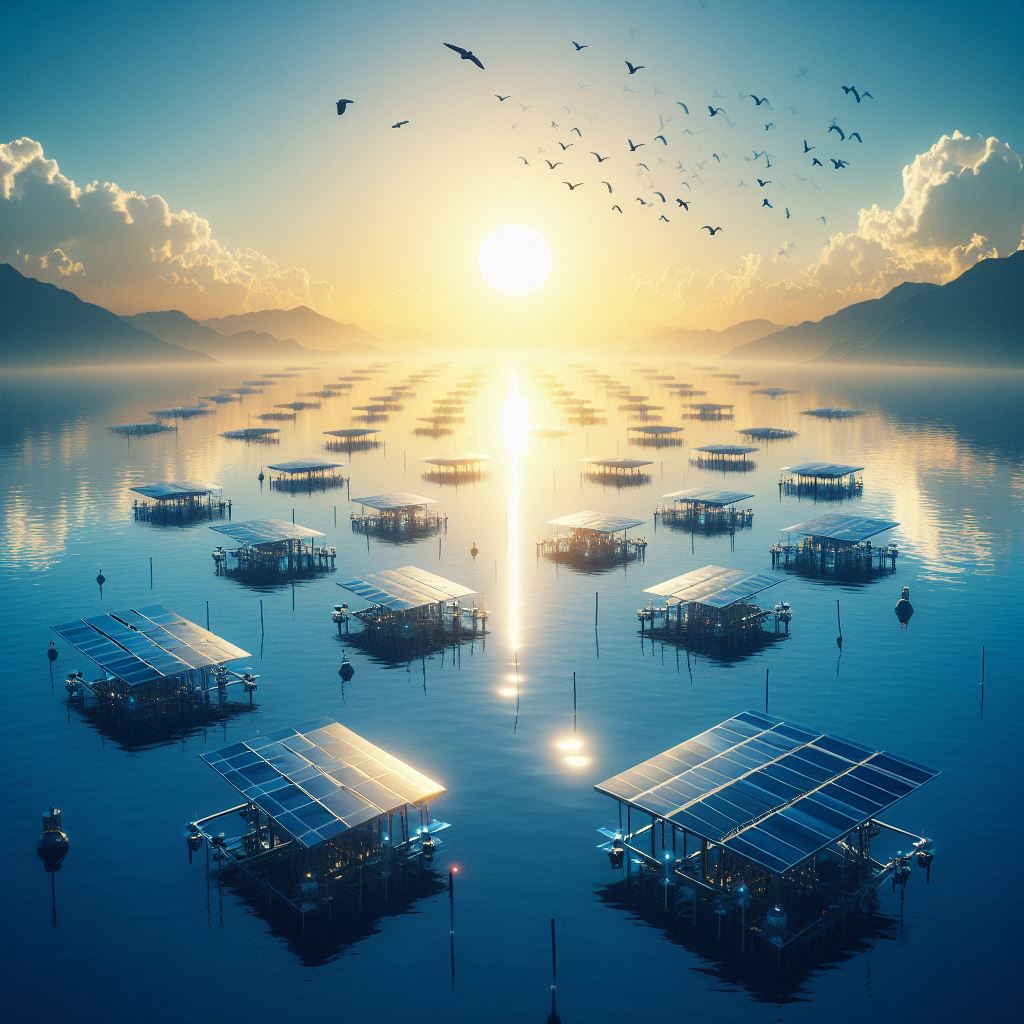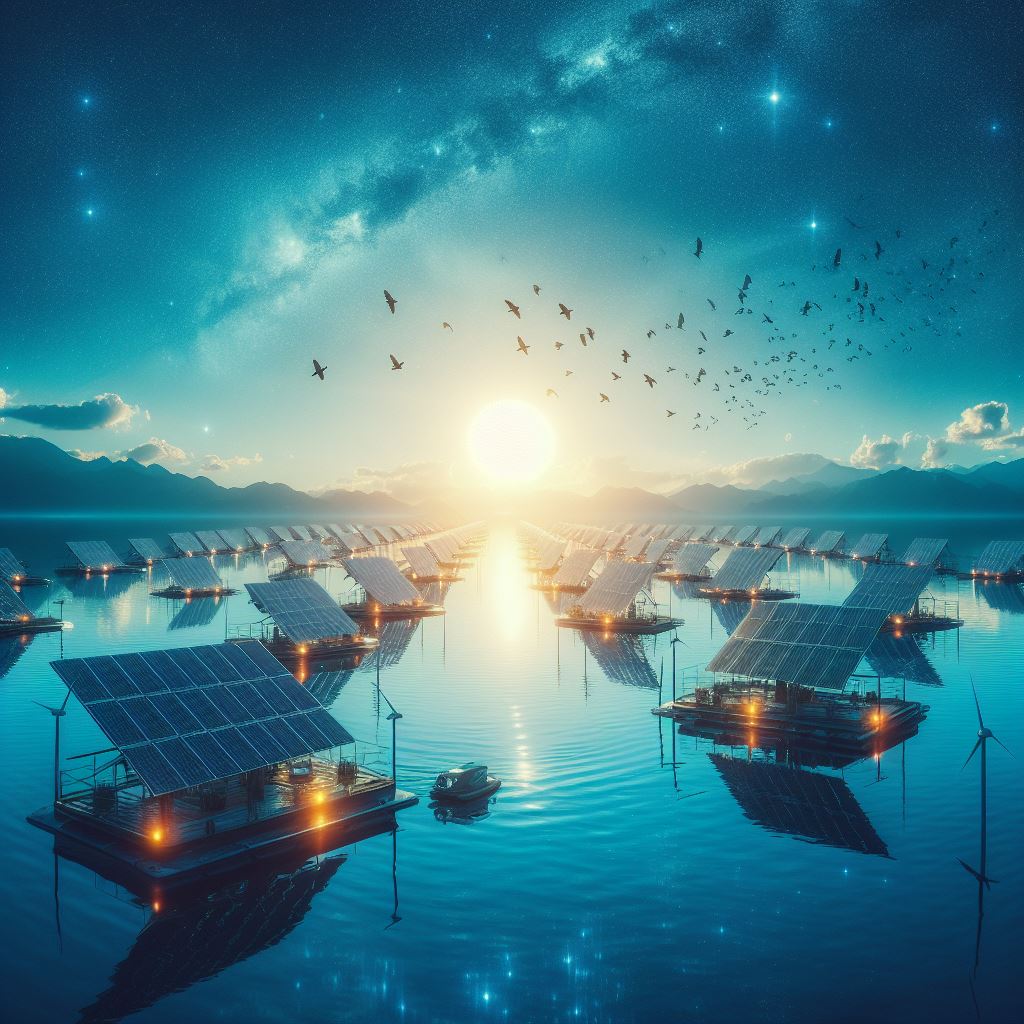
Floating solar farms offer a transformative solution by elegantly repurposing underutilized reservoirs, lakes, and other water bodies into power-generation hotspots. This innovative approach revitalizes these dormant spaces and conserves valuable land that could otherwise be utilized for agriculture or conservation efforts. By harnessing solar energy on the water’s surface, these floating solar installations capitalize on untapped renewable resources, providing a sustainable alternative to traditional land-based solar farms.
The cooling effect of the water enhances the efficiency of the solar panels, making them more productive. These floating solar farms can also reduce water evaporation and algae growth, further benefiting the ecological balance of the water bodies.
One of the standout advantages of floating photovoltaics is their inherent cooling mechanism. The water beneath the solar panels acts as a natural coolant, maintaining them at an optimal temperature. This natural cooling effect significantly enhances the efficiency of the floating solar farms compared to their land-based counterparts. It’s akin to providing solar panels with a rejuvenating drink of water as they diligently work to generate clean and sustainable energy. This unique feature maximizes the overall energy output. The reduced temperature can also mitigate the risk of thermal degradation, ensuring a more consistent and reliable energy supply.
In regions susceptible to drought, water evaporation poses a major concern. Utilizing floating solar panels to cover water bodies can substantially reduce evaporation rates, ensuring that our reservoirs remain fuller for extended periods. This approach guarantees a more consistent supply for agricultural irrigation and human consumption.
With the help of minimizing the exposure of water surfaces to direct sunlight, these floating solar installations act as protective shields, significantly reducing the loss of precious water through evaporation. This dual-purpose solution addresses both energy and water challenges, creating a sustainable and mutually beneficial system. The preserved water levels can support ecosystems dependent on these water bodies, fostering biodiversity and ecological balance. Therefore, incorporating floating solar technology serves as a strategic solution to mitigate the adverse effects of drought, promoting resilience and sustainability in water management and energy production.
Floating solar farms are characterized by their minimal ecological footprint, making them a sustainable choice for renewable energy production. These solar installations are often situated on manmade reservoirs, which mitigates the risk of disrupting natural aquatic ecosystems. Algae blooms can negatively impact water quality, depleting oxygen levels and posing risks to aquatic life.
Challenges
The durability of floating solar systems during extreme weather events remains a critical concern. Engineers and designers are tirelessly innovating to develop robust platforms capable of withstanding high winds, waves, and even occasional snowfall. However, it remains an ongoing challenge to contend with the unpredictable forces of Mother Nature. Advanced engineering solutions are being employed to reinforce the structural integrity of floating solar installations, incorporating resilient materials and innovative design features to enhance their resistance to adverse weather conditions.
Comprehensive risk assessment and mitigation strategies are being implemented to safeguard these systems against potential damages and ensure their long-term reliability and performance. Addressing the resilience and durability of floating solar technology is imperative to maximize its potential and sustainability. Through continuous research, development, and adaptation, the industry is striving to overcome these challenges and further solidify floating solar systems as a viable and resilient renewable energy solution.
Linking floating solar farms to the electrical grid presents technical challenges due to the dynamic nature of water bodies and their distance from existing infrastructure. The transmission of generated electricity from these remote locations demands innovative solutions to overcome these obstacles. Specialized technologies and engineering adaptations are required to ensure seamless and efficient connectivity between floating solar installations and the electrical grid. This may involve the use of advanced transmission equipment, underwater cables, and monitoring systems tailored to the unique conditions of aquatic environments.
While these technical complexities may necessitate higher initial investments, the long-term benefits of integrating floating solar technology into the grid are substantial. These include increased renewable energy capacity, reduced carbon emissions, and enhanced energy security and reliability. Addressing and resolving these connectivity challenges is crucial to unlocking the full potential of floating solar farms and advancing the transition to a more sustainable and resilient energy infrastructure.
While floating solar farms effectively reduce water evaporation, they can also impact the aquatic environment beneath them. The shading effect of the solar panels can limit sunlight penetration, potentially affecting the flora and fauna that depend on sunlight for growth and oxygen production. Maintaining a balanced approach is crucial to minimize disruption to these delicate ecosystems. Careful planning and design considerations are essential to ensure that the environmental impact of floating solar installations is mitigated.
This may include strategic placement of the solar panels to allow sufficient sunlight to reach the aquatic vegetation and organisms, as well as implementing measures to monitor and manage water quality and ecosystem health. Collaborative efforts between environmental experts, engineers, and designers are vital to develop sustainable floating solar solutions that harmoniously coexist with aquatic ecosystems.
Uncharted Potential
The potential for floating solar farms is vast and largely untapped. With only a fraction of the world’s water bodies currently hosting these green power plants, the scope for expansion is enormous. This could significantly contribute to our renewable energy mix, moving us closer to a sustainable future.
We are witnessing the emergence of increasingly efficient and durable solar panels specifically designed for aquatic environments. The future promises not only hardware improvements but also significant advancements in software capabilities. Anticipate the development of more sophisticated monitoring systems that can provide real-time data on energy production and environmental conditions. Furthermore, expect to see enhanced energy storage solutions that optimize the utilization of solar-generated power, ensuring a consistent energy supply even during periods of low sunlight or high demand.
Smarter integration with existing electrical grids will enable seamless and efficient distribution of renewable energy to consumers. These innovative developments are paving the way for a more resilient, adaptable, and intelligent renewable energy infrastructure.
Countries around the globe are beginning to understand the value of water-based solar power. Places with limited land but ample water bodies are prime candidates for these installations.

